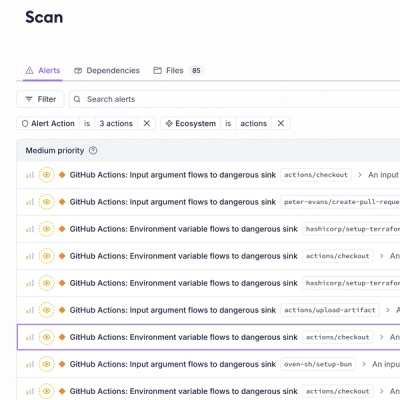
Product
Introducing Socket Firewall Enterprise: Flexible, Configurable Protection for Modern Package Ecosystems
Socket Firewall Enterprise is now available with flexible deployment, configurable policies, and expanded language support.
@wpe-tkpd/fake-indexeddb
Advanced tools
Fake IndexedDB: a pure JS in-memory implementation of the IndexedDB API
This is a pure JS in-memory implementation of the IndexedDB API. Its main utility is for testing IndexedDB-dependent code in Node.js.
npm install --save-dev fake-indexeddb
or
yarn add --dev fake-indexeddb
Functionally, it works exactly like IndexedDB except data is not persisted to disk.
The easiest way to use it is to import fake-indexeddb/auto, which will put all the IndexedDB objects in the global scope:
require("fake-indexeddb/auto");
var request = indexedDB.open("test", 3);
request.onupgradeneeded = function () {
var db = request.result;
var store = db.createObjectStore("books", {keyPath: "isbn"});
store.createIndex("by_title", "title", {unique: true});
store.put({title: "Quarry Memories", author: "Fred", isbn: 123456});
store.put({title: "Water Buffaloes", author: "Fred", isbn: 234567});
store.put({title: "Bedrock Nights", author: "Barney", isbn: 345678});
}
request.onsuccess = function (event) {
var db = event.target.result;
var tx = db.transaction("books");
tx.objectStore("books").index("by_title").get("Quarry Memories").addEventListener("success", function (event) {
console.log("From index:", event.target.result);
});
tx.objectStore("books").openCursor(IDBKeyRange.lowerBound(200000)).onsuccess = function (event) {
var cursor = event.target.result;
if (cursor) {
console.log("From cursor:", cursor.value);
cursor.continue();
}
};
tx.oncomplete = function () {
console.log("All done!");
};
};
Alternatively, you can import individual objects:
var indexedDB = require("fake-indexeddb");
var IDBKeyRange = require("fake-indexeddb/lib/FDBKeyRange");
// The rest is the same as above.
When importing individual classes directly (like var IDBKeyRange = require("fake-indexeddb/lib/FDBKeyRange"); above), file names of all the objects are like the
normal IndexedDB ones except with F replacing I, e.g. FDBIndex instead of IDBIndex.
If you import fake-indexeddb/auto before calling new Dexie(), it should work:
const Dexie = require("dexie");
require("fake-indexeddb/auto");
const db = new Dexie("MyDatabase");
The same likely holds true for other IndexedDB API wrappers like idb.
Alternatively, if you don't want to modify the global scope, then you need to explicitly pass the objects to Dexie:
const Dexie = require("dexie");
const indexedDB = require("fake-indexeddb");
const IDBKeyRange = require("fake-indexeddb/lib/FDBKeyRange");
const db = new Dexie("MyDatabase", { indexedDB: indexedDB, IDBKeyRange: IDBKeyRange });
To use this on a single Jest test suite, require fake-indexeddb/auto at the beginning of the test
file, as described above.
To use it on all Jest tests without having to require it in each file, add the auto setup script to the setupFiles in your Jest config:
"jest": {
...
"setupFiles": [
"fake-indexeddb/auto"
]
}
If you are keeping your tests completely isolated you might want to "reset" the state of the mocked indexedDB. You can do this by creating a new fakeIndexedDB instance, which lets you have a totally fresh start.
require("fake-indexeddb/auto");
const FDBFactory = require("fake-indexeddb/lib/FDBFactory");
// Whenever you want a fresh indexedDB
indexedDB = new FDBFactory();
PhantomJS (and other really old environments) are missing tons of modern JavaScript features. In fact, that may be why you use fake-indexeddb in such an environment! Prior to v3.0.0, fake-indexeddb imported core-js and automatically applied its polyfills. However, since most fake-indexeddb users are not using really old environments, I got rid of that runtime dependency in v3.0.0. To work around that, you can import core-js yourself before you import fake-indexeddb, like:
require("core-js/stable");
var indexedDB = require("fake-indexeddb");
Here's a comparison of fake-indexeddb and real browser IndexedDB implementations on the W3C IndexedDB test suite as of March 18, 2019:
| Implementation | Percentage of files that pass completely |
|---|---|
| Chrome 73 | 99% |
| Firefox 65 | 97% |
| Safari 12 | 92% |
| fake-indexeddb 3.0.0 | 87% |
| Edge 18 | 61% |
For browsers, I ran http://w3c-test.org/tools/runner/index.html and counted the passes. For fake-indexeddb, I ran npm run test-w3c.
87% is pretty good, right? Especially considering that fake-indexeddb runs in Node.js where failure is guaranteed for tests involving browser APIs like Web Workers. There are definitley still some weak points of fake-indexeddb, most of which are described in src/test/web-platform-tests/run-all.js. Your app will probably run fine, though.
Use as a mock database in unit tests.
Use the same API in Node.js and in the browser.
Support IndexedDB in old or crappy browsers.
Somehow use it within a caching layer on top of IndexedDB in the browser, since IndexedDB can be kind of slow.
Abstract the core database functions out, so what is left is a shell that allows the IndexedDB API to easily sit on top of many different backends.
Serve as a playground for experimenting with IndexedDB.
Apache 2.0
FAQs
Fake IndexedDB: a pure JS in-memory implementation of the IndexedDB API
We found that @wpe-tkpd/fake-indexeddb demonstrated a not healthy version release cadence and project activity because the last version was released a year ago. It has 7 open source maintainers collaborating on the project.
Did you know?

Socket for GitHub automatically highlights issues in each pull request and monitors the health of all your open source dependencies. Discover the contents of your packages and block harmful activity before you install or update your dependencies.

Product
Socket Firewall Enterprise is now available with flexible deployment, configurable policies, and expanded language support.

Security News
Open source dashboard CNAPulse tracks CVE Numbering Authorities’ publishing activity, highlighting trends and transparency across the CVE ecosystem.

Product
Detect malware, unsafe data flows, and license issues in GitHub Actions with Socket’s new workflow scanning support.